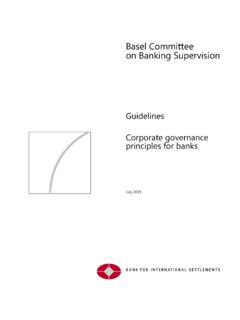Transcription of A Framework for Effective Management of Financial Crises
1 Developing a Framework for Effective Financial crisis Management by Dalvinder Singh and John Raymond LaBrosse . This article discusses the roles and responsibilities of the various agencies that are part of the Financial system safety net, and it sets out a Framework for the decision-making process for these actors in the Management of a Financial crisis . In this context, the article discusses issues of micro- and macro-prudential oversight and argues that more needs to be done to ensure accountability, independence, transparency and integrity of the various actors of the Financial system safety net. JEL Classification: G15, G21, G28. Keywords: Banks, Contingency Planning, Financial crisis Management , Financial System Safety Net, Financial Stability, Micro- and Macro-prudential Regulation, Systemic Risk.
2 Dalvinder Singh is associate professor at the University of Warwick, School of Law and John Raymond LaBrosse is an honorary visiting fellow at the University of Warwick, School of Law. The authors are grateful to Kendra LaBrosse and Christian Mecklenburg-Guzm n for their assistance with the tables and diagrams. Dalvinder would particularly like to thank Christian for his research assistance for this paper. The authors also would like to thank Sebastian Schich, Rodrigo Olivares-Caminal, David Mayes, and Charles Enoch for comments and suggestions. All views and indeed errors are the authors responsibility. The article was released in December 2011. The work is published on the responsibility of the Secretary- General of the OECD.
3 The opinions expressed and arguments employed herein do not necessarily reflect the official views of the Organisation or of the governments of its member countries. DEVELOPING A Framework FOR Effective Financial crisis Management . OECD work on Financial sector guarantees OECD work on Financial sector guarantees has intensified since the 2008 global Financial crisis as most policy responses for achieving and maintaining Financial stability have consisted of providing new or extended guarantees for the liabilities of Financial institutions. But even before this, guarantees were becoming an instrument of first choice to address a number of Financial policy objectives such as protecting consumers and investors and achieving better credit allocations.
4 A number of reports have been prepared that analyse Financial sector guarantees in light of ongoing market developments, incoming data, discussions within the OECD Committee on Financial Markets. The reports show how the perception of the costs and benefits of Financial sector guarantees has been evolving in reaction to Financial market developments, including the outlook for Financial stability. They are available at Financial safety net interactions Deposit insurance Funding systemic crisis resolution Government-guaranteed bank bonds Guarantees to protect consumers and Financial stability As part of that work, the Symposium on Financial crisis Management and the use of government guarantees , held at the OECD in Paris on 3 and 4 October 2011, focused on bank failure resolution and crisis Management , in particular, the use of guarantees and the interconnections between banking and sovereign debt.
5 Conclusions from the Symposium are included at the back of this article. This article is one of nine prepared for presentation at this Symposium. Managing Crises without guarantees: How do we get there? Costs and benefits of bank bond guarantees Sovereign and banking debt interconnections through guarantees Impact of banking Crises on public finances Fault lines in cross-border banking: Lessons from Iceland The macro-prudential authority: Powers, Scope and Accountability Effective practises in crisis Management The Federal Agency for Financial Market Stabilisation in Germany The new EU architecture to avert a sovereign debt crisis 2 OECD JOURNAL: Financial MARKET TRENDS VOLUME 2011 ISSUE2 OECD 2012.
6 DEVELOPING A Framework FOR Effective Financial crisis Management . 1 Introduction Public confidence plays an important role in sustaining Financial system stability. In normal times the regulation and supervision of banks, the promotion and use of standards of sound business and Financial practice, central bank actions, explicit deposit protection and an Effective bank closure mechanism all help to reduce the adverse consequences of a Financial crisis emanating from bank failures. It is understood that banks, like other firms, will fail1 and the likelihood of this happening is higher when risks in a particular banking concern are not managed appropriately, bubbles in certain markets burst or Financial markets are very fragile due to either domestic or foreign reasons.
7 In almost all circumstances private sector solutions, such as rights issues or mergers, should be pursued in the first instance to deal with problem or failing banks, as in most cases they can limit the pressure on the Financial system safety net (FSN). However, when problems become systemic governments tend to play a much more active role and call upon the agencies that make up the FSN to undertake extraordinary measures. Intervention can take a variety of forms. As such, there is a clear need for officials to undertake coherent contingency planning, Financial risk assessment and crisis Management . A significant development on that front has been the introduction of Financial stability forums in the form of committees in individual countries to oversee agencies within the official safety net and improve how they govern macro-prudential and micro-prudential issues (Nier et al 2011).
8 2 However, Financial stability committees are not new and the reinvigoration of a formal oversight body is unlikely to fulfil all that is expected of it. This gives rise to an expectations gap, which we explore. It is trite to say, but Financial market Crises occur on a regular basis with similar causes, as explained by Reinhart and Rogoff (2009); however, recent experience suggests that very little attention has been given to how best to manage them. One explanation could be that one crisis seems to lead to another, so it is difficult to determine the endpoints. Another explanation might be that crisis Management needs more attention so that lessons learned can be incorporated into improved techniques to minimise the effects of catastrophic events.
9 Notwithstanding the fact that a considerable amount has been learnt about crisis Management from past experiences, lessons from the past seem to be amiss in terms of guiding future directions, so the risk of repeating mistakes arises. This article focuses on measures used to contain a Financial crisis , and generally takes account of events in the European Union (EU). We review the experience of the crisis so far and seek to draw some conclusions on how it was overseen and managed based on that analysis. Section 2 sets out the main structure of a FSN and describes how the mandates, roles and responsibilities of the agencies within it tend to change during the course of a crisis .
10 Attention is also given to the interests and impact that stakeholders, in the marketplace outside the FSN can have during a bank failure or Financial disaster. The paper sets out why careful attention to the FSN and the market stakeholders is now quite important. Recent experience offers many examples of the need for more clarity in the Management of a crisis . To help policy-makers a decision tree is offered and explained in section 3 as an alternative to the spurt of ad hoc pronouncements that have done little more than confuse markets and undermine the public s confidence in policy-makers. One of the clear messages is the need for more Effective oversight of micro- and macro-prudential factors.













